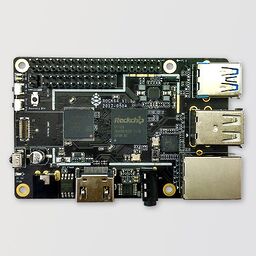NixOS on ARM/PINE64 ROCK64: Difference between revisions
imported>Bennofs |
imported>Lopsided98 Update to account for upstream U-Boot |
||
| Line 26: | Line 26: | ||
== Status == | == Status == | ||
This board has upstream U-Boot and kernel support, although the mainline kernel may still be missing some features. NixOS can be installed using manual partitioning and <code>nixos-install</code> or by modifying the aarch64 installation image as described in the next section. | |||
U-Boot for this board is packaged in nixpkgs, and Hydra builds can be found here: https://hydra.nixos.org/job/nixpkgs/trunk/ubootRock64.aarch64-linux | U-Boot for this board is packaged in nixpkgs, and Hydra builds can be found here: https://hydra.nixos.org/job/nixpkgs/trunk/ubootRock64.aarch64-linux | ||
This bootloader is not entirely open, incorporating a blob for the tertiary program loader (TPL). | This bootloader is not entirely open, incorporating a binary blob for the tertiary program loader (TPL). | ||
== Board-specific installation notes == | == Board-specific installation notes == | ||
U-Boot needs to be copied to | U-Boot needs to be copied to specific sectors on the microSD card, eMMC or image with <code>dd</code>. Download/build U-Boot for the board, and write <code>idbloader.img</code> and <code>u-boot.itb</code> to the correct locations with (replace <code>/dev/mmcblkX</code> with the correct path to the card or image): | ||
<syntaxhighlight lang="bash"> | <syntaxhighlight lang="bash"> | ||
dd if=idbloader.img of=/dev/mmcblkX conv=fsync,notrunc bs=512 seek=64 | |||
dd if=u-boot.itb of=/dev/mmcblkX conv=fsync,notrunc bs=512 seek=16384 | |||
</syntaxhighlight> | |||
{{note|Prior to NixOS 20.03, a downstream version of U-Boot 2017.09 was packaged, which placed U-Boot in a single <code>idbloader.img</code> file. If that version is used, simply disregard the second command above.}} | |||
< | |||
== Serial console== | == Serial console== | ||
| Line 70: | Line 66: | ||
== Compatibility notes == | == Compatibility notes == | ||
{| class="table arm-compatibility" | {| class="table arm-compatibility" | ||
! | | | ||
! style="background: #fafafa" | Mainline kernel !! style="background: #fafafa" | ayufan-rock64/linux-mainline-kernel | |||
|- | |- | ||
! Ethernet | ! Ethernet | ||
| | | Works || Works | ||
|- | |- | ||
! USB | ! USB | ||
| | | As of 5.4, USB 3.0 does not work || Works | ||
| | |||
| | |||
|- | |- | ||
! | ! HDMI | ||
| | | Works || Works | ||
|} | |} | ||
| Line 102: | Line 88: | ||
* [https://github.com/ayufan-rock64/linux-mainline-kernel ayufan-rock64/linux-mainline-kernel] mainline based, with potentially fewer hardware features supported. This kernel is not based on a kernel stable branch, so it may have more bugs (unrelated to the hardware). | * [https://github.com/ayufan-rock64/linux-mainline-kernel ayufan-rock64/linux-mainline-kernel] mainline based, with potentially fewer hardware features supported. This kernel is not based on a kernel stable branch, so it may have more bugs (unrelated to the hardware). | ||
{{note|The | {{note|The old vendor U-Boot 2017.09 did not leave enough room between the kernel and initrd, causing recent kernels to overwrite the beginning of the initrd. This can be fixed by increasing <code>ramdisk_addr_r</code> in the U-Boot console, or using upstream U-Boot. }} | ||
== Resources == | == Resources == | ||
* [https://www.pine64.org/?page_id=7147 Official product page] | * [https://www.pine64.org/?page_id=7147 Official product page] | ||
Revision as of 04:40, 6 December 2019
| PINE64 ROCK64 | |
|---|---|

| |
| Manufacturer | PINE64 (Pine Microsystems Inc.) |
| Architecture | AArch64 |
| Bootloader | Downstream (ayufan) U-Boot[1] |
| Boot options | SD, eMMC, SPI NOR Flash |
The ROCK64 is a single board computer built around the Rockchip RK3328 SoC.
There are three models of the board, with 1, 2 or 4 GB of RAM. It can boot from an microSD card or an eMMC. It also has a 128 Mbit SPI flash that can be used to store the bootloader.
Status
This board has upstream U-Boot and kernel support, although the mainline kernel may still be missing some features. NixOS can be installed using manual partitioning and nixos-install or by modifying the aarch64 installation image as described in the next section.
U-Boot for this board is packaged in nixpkgs, and Hydra builds can be found here: https://hydra.nixos.org/job/nixpkgs/trunk/ubootRock64.aarch64-linux This bootloader is not entirely open, incorporating a binary blob for the tertiary program loader (TPL).
Board-specific installation notes
U-Boot needs to be copied to specific sectors on the microSD card, eMMC or image with dd. Download/build U-Boot for the board, and write idbloader.img and u-boot.itb to the correct locations with (replace /dev/mmcblkX with the correct path to the card or image):
dd if=idbloader.img of=/dev/mmcblkX conv=fsync,notrunc bs=512 seek=64
dd if=u-boot.itb of=/dev/mmcblkX conv=fsync,notrunc bs=512 seek=16384
idbloader.img file. If that version is used, simply disregard the second command above.Serial console
The ROCK64 uses a GPIO pinout compatible with the Raspberry Pi 2 and newer. This means that the following pins can be used to connect a serial adapter:
| Pi-2 Bus | |
|---|---|
| Pin | Function |
| 6 | GND |
| 8 | UART0_TX |
| 10 | UART0_RX |
The serial console runs at 1500000 baud in the bootloader. When using the standard NixOS aarch64 sd image, set console=ttyS2,115200n8 as kernel option in extlinux/extlinux.conf on the boot partition of the sdimage to get a serial linux console. For debugging, console=uart8250,mmio32,0xff130000 should give you an early UART console, before the full serial console is up.
Compatibility notes
| Mainline kernel | ayufan-rock64/linux-mainline-kernel | |
|---|---|---|
| Ethernet | Works | Works |
| USB | As of 5.4, USB 3.0 does not work | Works |
| HDMI | Works | Works |
Downstream kernel
To use all hardware functionality, it is currently necessary to use a downstream kernel:
- ayufan-rock64/linux-kernel 4.4 based on Rockchip BSP
- ayufan-rock64/linux-mainline-kernel mainline based, with potentially fewer hardware features supported. This kernel is not based on a kernel stable branch, so it may have more bugs (unrelated to the hardware).
ramdisk_addr_r in the U-Boot console, or using upstream U-Boot. 